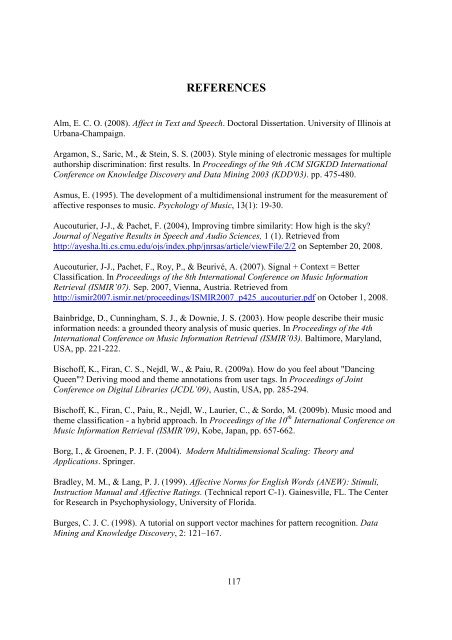improving music mood classification using lyrics, audio and social tags
improving music mood classification using lyrics, audio and social tags
improving music mood classification using lyrics, audio and social tags
You also want an ePaper? Increase the reach of your titles
YUMPU automatically turns print PDFs into web optimized ePapers that Google loves.
REFERENCES<br />
Alm, E. C. O. (2008). Affect in Text <strong>and</strong> Speech. Doctoral Dissertation. University of Illinois at<br />
Urbana-Champaign.<br />
Argamon, S., Saric, M., & Stein, S. S. (2003). Style mining of electronic messages for multiple<br />
authorship discrimination: first results. In Proceedings of the 9th ACM SIGKDD International<br />
Conference on Knowledge Discovery <strong>and</strong> Data Mining 2003 (KDD'03). pp. 475-480.<br />
Asmus, E. (1995). The development of a multidimensional instrument for the measurement of<br />
affective responses to <strong>music</strong>. Psychology of Music, 13(1): 19-30.<br />
Aucouturier, J-J., & Pachet, F. (2004), Improving timbre similarity: How high is the sky?<br />
Journal of Negative Results in Speech <strong>and</strong> Audio Sciences, 1 (1). Retrieved from<br />
http://ayesha.lti.cs.cmu.edu/ojs/index.php/jnrsas/article/viewFile/2/2 on September 20, 2008.<br />
Aucouturier, J-J., Pachet, F., Roy, P., & Beurivé, A. (2007). Signal + Context = Better<br />
Classification. In Proceedings of the 8th International Conference on Music Information<br />
Retrieval (ISMIR’07). Sep. 2007, Vienna, Austria. Retrieved from<br />
http://ismir2007.ismir.net/proceedings/ISMIR2007_p425_aucouturier.pdf on October 1, 2008.<br />
Bainbridge, D., Cunningham, S. J., & Downie, J. S. (2003). How people describe their <strong>music</strong><br />
information needs: a grounded theory analysis of <strong>music</strong> queries. In Proceedings of the 4th<br />
International Conference on Music Information Retrieval (ISMIR’03). Baltimore, Maryl<strong>and</strong>,<br />
USA, pp. 221-222.<br />
Bischoff, K., Firan, C. S., Nejdl, W., & Paiu, R. (2009a). How do you feel about "Dancing<br />
Queen"? Deriving <strong>mood</strong> <strong>and</strong> theme annotations from user <strong>tags</strong>. In Proceedings of Joint<br />
Conference on Digital Libraries (JCDL’09), Austin, USA, pp. 285-294.<br />
Bischoff, K., Firan, C., Paiu, R., Nejdl, W., Laurier, C., & Sordo, M. (2009b). Music <strong>mood</strong> <strong>and</strong><br />
theme <strong>classification</strong> - a hybrid approach. In Proceedings of the 10 th International Conference on<br />
Music Information Retrieval (ISMIR’09), Kobe, Japan, pp. 657-662.<br />
Borg, I., & Groenen, P. J. F. (2004). Modern Multidimensional Scaling: Theory <strong>and</strong><br />
Applications. Springer.<br />
Bradley, M. M., & Lang, P. J. (1999). Affective Norms for English Words (ANEW): Stimuli,<br />
Instruction Manual <strong>and</strong> Affective Ratings. (Technical report C-1). Gainesville, FL. The Center<br />
for Research in Psychophysiology, University of Florida.<br />
Burges, C. J. C. (1998). A tutorial on support vector machines for pattern recognition. Data<br />
Mining <strong>and</strong> Knowledge Discovery, 2: 121–167.<br />
117
















